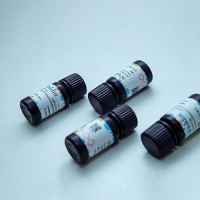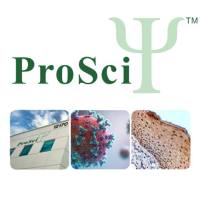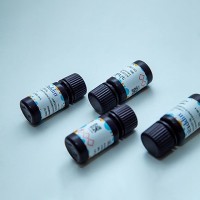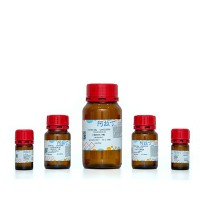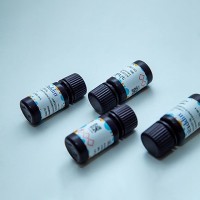Characterization of Angiotensin II Receptors
互联网
- Abstract
- Table of Contents
- Materials
- Figures
- Literature Cited
Abstract
Angiotensin II (Ang II) is the primary mediator of the renin angiotensin system and acts primarily as a circulating hormone, but may also act as a paracrine or autocrine factor. Ang II binds specifically to G protein?coupled receptors and triggers a number of characteristic cellular responses, including vascular smooth muscle contraction and adrenal cellular aldosterone secretion. There are multiple receptor subtypes for Ang II; however, the distinction between binding sites versus receptors with their associated functional manifestations has been controversial. There are two principal human receptor subtypes, designated AT1 and AT2 , that are distinguished by the selective affinity of the nonpeptide antagonists losartan and PD123177. In rodents, additional isoforms of the Ang II receptor have been cloned (e.g., AT1A and AT1B ), although their functional distinctions are undetermined. The focus of this unit is the identification of Ang II binding sites and receptor subtypes. Radioligand competition binding assays are provided for determining the affinity of Ang II for receptors on adrenal cortical microsomes, whole adrenal membranes, or CHO cells transfected with the AT1A receptor.
Table of Contents
- Basic Protocol 1: Measurement of Angiotensin II Affinity Using Competition Binding Assays in Adrenal Cortical Microsomes
- Alternate Protocol 1: Measurement of Angiotensin II Affinity for Specific Receptor Subtypes in Whole Adrenal Membranes
- Alternate Protocol 2: Measurement of Angiotensin II Affinity for Cloned Receptors on Transfected Cells
- Reagents and Solutions
- Commentary
- Literature Cited
- Figures
- Tables
Materials
Basic Protocol 1: Measurement of Angiotensin II Affinity Using Competition Binding Assays in Adrenal Cortical Microsomes
Materials
Alternate Protocol 1: Measurement of Angiotensin II Affinity for Specific Receptor Subtypes in Whole Adrenal Membranes
Alternate Protocol 2: Measurement of Angiotensin II Affinity for Cloned Receptors on Transfected Cells
|
Figures
-
Figure 1.10.1 Displacement of [125 I]Ang II by unlabeled Ang II in rat adrenal cortical microsomes plotted by KaleidaGraph curve fit (m0 = [Ang II]; m1 = IC50 ). NA, not applicable. View Image -
Figure 1.10.2 Inhibition of [125 I][Sar1 Ile8 ]Ang II binding by unlabeled Ang II and saralasin in rat whole adrenal membranes pretreated with PD123319 to block AT2 sites. The IC50 values for Ang II and saralasin are 16 nM and 0.36 nM, respectively. The IC50 values were calculated by linear regression analysis of the logit transform of the parent bound data. View Image -
Figure 1.10.3 The inhibition of [125 I]Ang II binding in intact Chinese hamster ovary cells expressing AT1A receptors. The IC50 values are 2.3 nM (Ang II), 22 nM (losartan), >1 µM (PD123177), 1.7 nM (saralasin), 87 nM (Ang I—reflects conversion to Ang II), and 6.4 nM (Ang III). IC50 calculations were performed as in Table and Figure . View Image -
Figure 1.10.4 Displacement of [125 I]Ang II by unlabeled Ang II in rat adrenal cortical microsomes. (A ) Increasing concentrations of [125 I]Ang II were added to a fixed amount of adrenal cortical membrane homogenate to create a ligand displacement curve (data from Table ). Nonspecific binding was determined in the presence of 10 µM unlabeled Ang II. (B ) The Scatchard plot produces a straight line and provides evidence for interaction of Ang II with a single site. The K d for unlabeled Ang II is 3.934 nM, and the B max is 2.468 pmol/mg of protein. Data were analyzed using LIGAND. B, bound; F, free; T, unlabeled [Ang II] (M). View Image
Videos
Literature Cited
| Catt, K.J., Sandberg, K., and Balla, T. 1993. Angiotensin II receptors and signal transduction mechanisms. In Cellular and molecular biology of the renin angiotensin system (M.K. Raizada, M.I. Phillips, and C. Sumners, eds.) pp. 307‐356. CRC Press, Boca Raton, Fla. | |
| Chang, R.S.L., Lotti, V.J., Chen, T.B., and Faust, K.A. 1990. Two angiotensin II binding sites in rat brain revealed using 125I‐Sar1‐Ile8‐angiotensin II and selective nonpeptide antagonists. Biochem. Biophys. Res. Commun. 171:813‐817. | |
| Chang, R.S.L., Lotti, V.J., Chen, T.B., Omalley, S.S., Bendesky, R.J., Kling, P.J., Kivlighn, S.D., Siegl, P.K.S., Ondeyka, D., Greenlee, W.J., and Mantlo, N.B. 1995. In vitro pharmacology of an angiotensin AT(1) receptor antagonist with balanced affinity for AT(2) receptors. Eur. J. Pharmacol. 294:429‐437. | |
| Chiu, A.T., Herblin, W.F., Ardecky, R.J., McCall, D.E., Carini, D.J., Duncia, J.V., Pease, L.J., Wexler, R.R., Wong, P.C., Johnson, A.L., and Timmermans, P.B.M.W.M. 1989a. Identification of angiotensin II receptor subtypes. Biochem. Biophys. Res. Commun. 165:196‐203. | |
| Chiu, A.T., Duncia, J.V., McCall, D.E., Wong, P.C., Price, W.A., Thoolen, M.J.M.C., Carini, D.J., Johnson, A.L., and Timmermans, P.B.M.W.M. 1989b. Nonpeptide angiotensin II receptor antagonists. III. Structure‐function studies. J. Pharmacol. Exp. Ther. 250:867‐874. | |
| Chiu, A.T., McCall, D.E., Aldrich, P.E., and Timmermans, P.B.M.W.M. 1990. 3H]DuP 753, a highly potent and specific radioligand for the angiotensin II‐1 receptor subtype. Biochem. Biophys. Res. Commun. 172:1195‐1202. | |
| Chiu, A.T., Carini, D.J., Duncia, J.V., Leung, K.H., McCall, D.E., Price, W.A., Wong, P.C., Smith, R.D., Wexler, R.R., and Timmermans, P.B.M.W.M. 1991. DuP 532: A second generation of nonpeptide angiotensin II receptor antagonists. Biochem. Biophys. Res. Commun. 177:209‐217. | |
| Chiu, A.T., Dunscomb, J.H., McCall, D.E., Benfield, P., Baubonis, W. and Sauer, B. 1993. Characterization of angiotensin AT1A receptor isoform by its ligand binding signature. Regul. Pept. 44:141‐147. | |
| Christ, D.D. 1995. Human plasma protein binding of the angiotensin II receptor antagonist losartan potassium (DuP 753/MK 954) and its pharmacologically active metabolite EXP3174. J. Clin. Pharmacol. 35:515‐520. | |
| Cox, B.E., Word, R.A., and Rosenfeld, C.R. 1996. Angiotensin II receptor characteristics and subtype expression in uterine arteries and myometrium during pregnancy. J. Clin. Endocrinol. Metab. 81:49‐58. | |
| DeGasparo, M., Husain, A., Alexander, W., Catt, K.J., Chiu, A.T., Drew, M., Goodfriend, T., Harding, J.W., Inagami, T. and Timmermans, P.B.M.W.M. 1995. Proposed update of the angiotensin receptor nomenclature. Hypertension 25:924‐927. | |
| Feral, C., Benhaim, A., and Leymarie, P. 1996. Angiotensin II receptor type I on granulosa and thecal cells of rabbit preovulatory follicles. Biochim. Biophys. Acta 1284:221‐226. | |
| Fukushige, S. and Sauer, B. 1992. Genomic targeting with a positive selection 10X integration reactor allows highly reproducible gene expression in mammalian cells. Proc. Natl. Acad. Sci. U.S.A. 89:7905‐7909. | |
| Griendling, K.K., Lassegue, B., and Alexander, R.W. 1996. Angiotensin receptors and their therapeutic implications. Annu. Rev. Pharmacol. Toxicol. 36:281‐306. | |
| Grove, K.L., and Speth, R.C. 1993. Angiotensin II and nonangiotensin II displaceable binding sites for [3H]losartan in the rat liver. Biochem. Pharmacol. 46:1653‐1660. | |
| Johren, O., Viswanathan, M., and Saavedra, J.M. 1995. Expression of the non‐angiotensin II I‐12undefinedCGP‐42112 binding sites on activated microglia after kainic acid‐induced neurodegeneration. Brain Res. 702:153‐161. | |
| McQueen, J., and Semple, P.F. 1991. Angiotensin receptor assay and characterization. In Methods in neurosciences (P.M. Conn, ed.) pp. 312‐330. Academic Press, San Diego. | |
| Meffert, S., Stoll, M., Steckelings, U.M., Bottari, S.P., and Unger, T. 1996. The angiotensin II AT2 receptor inhibits proliferation and promotes differentiation in PC12W cells. Mol. Cell. Endocrinol. 122:59‐67. | |
| Nouet, S., Dodey, P., Renaut, P., Marie, J., Pruneau, D., Larguier, R., Lombard, C., and Bonnafous, J.C. 1994. Properties of 3H‐LF7‐0156, a new nonpeptide antagonist radioligand for the type 1 angiotensin II receptor. Mol. Pharmacol. 46:693‐701. | |
| Nozawa, Y., Miyake, H., Haruno, A., Yamada, S., Uchida, S., Ohkura, T., Kimura, R., Suzuki, H., and Hoshino, T. 1996. Down regulation of angiotensin II receptors in hypertrophied human myocardium. Clin. Exp. Pharmacol. Physiol. 23:514‐518. | |
| Rogg, H., DeGasparo, M., Graedel, E., Stulz, P., Burkart, F., Eberhard, M., and Erne, P. 1996. Angiotensin II receptor subtypes in human atria and evidence for alterations in patients with cardiac dysfunction. Eur. Heart J. 17:1112‐1120. | |
| Schambye, H.T., Hjorth, S.A., Weinstock, J., and Schwartz, T.W. 1995. Interaction between the nonpeptide angiotensin antagonist SKF108566 and histidine‐256 (HISVI‐16) of the angiotensin type 1 receptor. Mol. Pharmacol. 47:425‐431. | |
| Smith, R.D., and Timmermans, P.B.M.W.M. 1994. Human angiotensin receptor subtypes. Curr. Opin. Nephrol. Hypertens. 3:112‐122. | |
| Timmermans, P.B.M.W.M., and Smith, R.D. 1994. Angiotensin II receptor subtypes: Selective antagonists and functional correlates. Eur. Heart J. 15(Suppl D):79‐87. | |
| Timmermans, P.B.M.W.M., Wong, P.C., Chiu, A.T., Herblin, W.F., Benfield, P., Carini, D.J., Lee, R.J., Wexler, R.R., Saye, J.M., and Smith, R.D. 1993. Angiotensin II receptors and angiotensin II receptor antagonists. Pharmacol. Rev. 45:205‐251. | |
| Wexler, R.R., Greenlee, W.J., Irvin, J.D., Goldberg, M.R., Prendergast, K., Smith, R.D., and Timmermans, P.B.M.W.M. 1996. Nonpeptide angiotensin II receptor antagonists: The next generation in antihypertensive therapy. J. Med. Chem. 39:625‐656. | |
| Whitebread, S., Mele, M., Kamber, B., and DeGasparo, M. 1989. Preliminary biochemical characterization of two angiotensin II receptor subtypes. Biochem. Biophys. Res. Commun. 163:284‐291. | |
| Key References | |
| DeGasparo et al., 1995. See above. | |
| Provides recommended nomenclature and operational characteristics for Ang II receptors. | |
| Griendling et al., 1996. See above. | |
| Current overview of Ang II receptors describing receptor structure, function, and therapeutic implications. | |
| McQueen, and Semple, 1991. See above. | |
| Excellent review of Ang II receptor assay methodology. | |
| Timmermans et al., 1993. See above. | |
| Comprehensive review of history of Ang II, Ang II receptor heterogeneity, and the discovery of nonpeptide receptor antagonists. |
